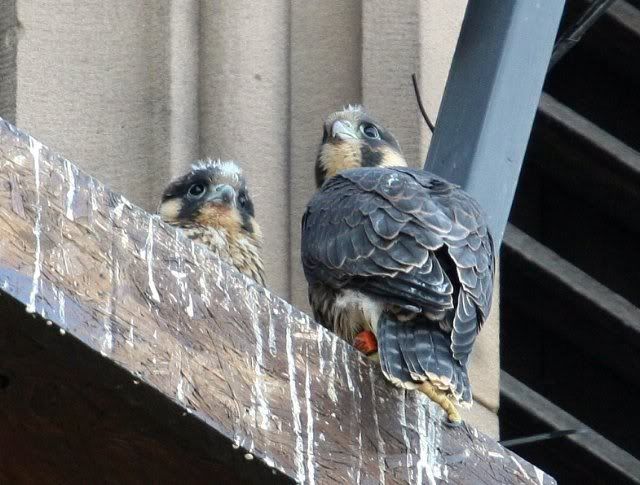I received many questions about what happens after we have seen the juvies leave the nestsite.
Many of the nestsites we have been watching on this Blog are abandoned. The hatchlings have grown up to juveniles in around 42 days and have fledged. What we see is an empty nestsite.
What happens after the fledglings have left. Do they fly immediately like never did anything else. Do they stay with their parents or do they leave? Lot of questions on which some answers.

When the juvies are standing flapping and scuawking on the edge of the ledge and leave the ground for the very first time it does not mean they immediately fly like and eagle. In the contrary. For most of them it is complete panic. They flap their wings like crazy which is not the way to fly and are sinking to the ground like Icarus in de sun. Most of the maiden flights are crashflights. They end up on a rooftop, an edge of a building, in a tree or worse on the street with busy traffic. For many juvies the first flight is the last one and they end up dead. The bigcity nestsites with webcams fortunately have often a team of volunteers who watch the fledglings and help when necessary. Which is quite often.
With nestsites in National Parks there is often no help, but the dangers are much less of course. The feldgling could end up in a tree and will be helped and fed by the parents. They always watch over their chicks, wherever they are.
The problem is that the flight muscles are not yet strong enough to gain height on first flight. It takes a lot of strenght to overcome drag. And experience to take advantage of gravity and airflow, of wingload and the own airfoilform of body and wings. Sure they are born to fly, but just as we have to learn to walk, they do have to learn how to fly. One other matter is that the flightfeathers are not fully grown and still weak. They need to grow a bit nore and harden to be able to provide in perfect flying.

Most of the juvies progress from Butterfly-Flight (1–2 d after first flight) to Flutter-Glide (3–9 d) to Powered Flight (15–25 d). Butterfly-Flight appears to be a weaker form of Flutter-Glide associated with in-complete development of flight feathers and pectoral muscles. They love to pursuit the parents and beg for food which they accompany with loud Begging vocalization. During first 2 wk of flight, young birds’ pursuit of parents and eachother takes precedence over most other activities. Young will even pursue parents during territorial defense!
The juvies spent a lot of time practising stoop and preycatching flights on eachother. Siblings motivate eachother in pursuit in the air, under loud vocalizations, grabbing eachothers tails, turning in the air, trying to grab eachother with talons,having a lot of fun! It's a joy watching them. They just play like children, just as happy and innocent as our own young children.

As the juvies become more aggressive toward food-delivering parents, adults begin to drop both dead and live birds in air. Young dive and catch these items. Has been interpreted as parental training of young to hunt, but may also be a way for parents to avoid being mobbed by hungry young.
In migratory populations, dependency may continue until onset of migration 5–6 wk postfledging. Period of dependency is much longer in nonmigratory pop-ulations (9–10 wk postfledging).

During this time the juvies take off in the morning for long flights, coming back in the evening to spent the night at home. Sometimes stay away for 2 days. Until that special morning they leave their birthground and parents forever and start a life of their own. Quite often they leave together in pairs to spent the first weeks and months and even the first winter together. Or just go alone and perhaps meet another juvi from another nestsite to bond with. Even that is possible. The peregrine couple from the Dutch Zwolle nestiste where born just 35 km from eachother in Germany, and hatched almost the same day. They met when fledging and never left eachother anymore. This year they took over the Zwolle nestsite and had their very first clutch. Their first 3 juvies have just fledged, which makes the Circle of life round....
Photo's are courtesy of Colin Pass.










No comments:
Post a Comment